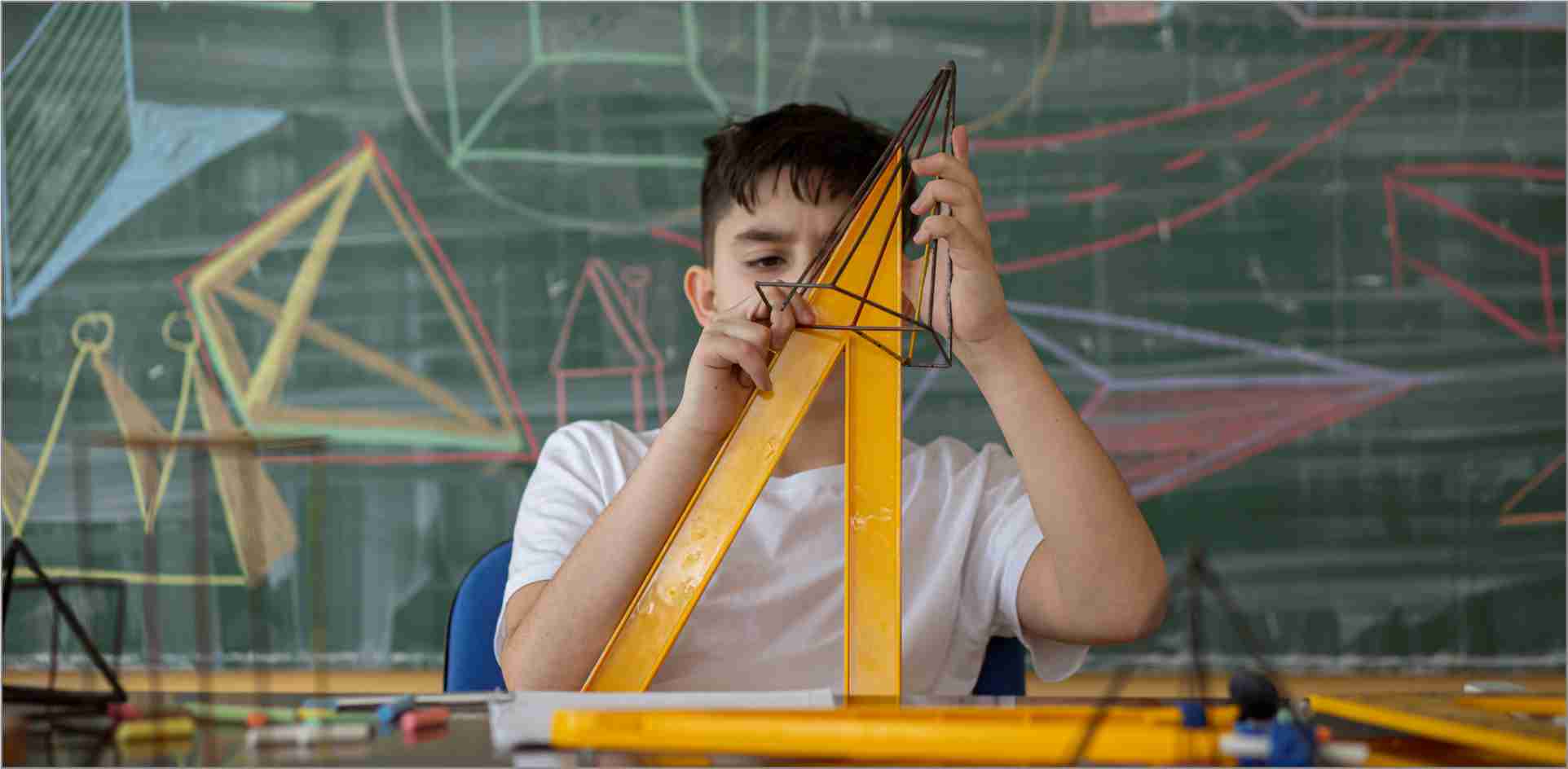![]()
Early years are crucial for brain development in children, and providing stimulating activities can significantly enhance their cognitive abilities. Research shows that about 90% of a child’s brain develops during early childhood. This makes it essential to engage children in activities that promote cognitive skills development and support their brain’s healthy growth. Math puzzles and mind games can significantly enhance brain development when paired with play, nutrition, and early education.
Research from the National Library of Medicine highlights a strong link between brain health and brain exercises like mathematical puzzles. These activities not only improve cognitive flexibility but also foster critical thinking, analytical skills, and problem-solving techniques. Moreover, mathematical puzzles make learning fun while strengthening cognitive skills and boosting logical reasoning.
Here’s how different types of math challenges for children can help sharpen their minds and strengthen their cognitive abilities.
Math Crossword
Math crosswords are like traditional word crosswords, but instead of letters, children fill in the grid with digits to solve vertical and horizontal calculations. Each blank square corresponds to a number, guided by mathematical clues. Starting with simple puzzles focused on one operation, like addition, builds confidence. As learners/students progress, multiple operations can be introduced, enhancing their arithmetic skills and critical thinking. Overall, math crosswords offer a fun and interactive way for children to practise math while engaging their minds.
Sudoku
Sudoku is a widely popular number puzzle that focuses on logical thinking. The puzzle requires filling a 9×9 grid so that each row, column, and 3×3 grid within the larger grid contains the digits 1–9 without repetition. Sudoku is ideal for school- going children as it stimulates their ability to spot patterns and apply logic. As they work through the puzzle, children
learn to apply deduction and develop a systematic approach to problem-solving. Successfully completing a Sudoku puzzle not only boosts their confidence but also fosters a positive attitude toward math and challenges.
Math Riddles and Brain Teasers
Cognitive flexibility and puzzles go hand-in-hand, and math riddles are a great way to exercise that flexibility. You can easily create riddles from everyday scenarios, making them relatable and fun. For example:
The Multiplying Bricks:
A brick weighs 1 kg plus half a brick. What is the weight of a full brick?
Answer: 2 kg (Set up the equation: Brick = 1 kg + ½ Brick)
Age Riddle:
Aman is 5 years older than his brother. If the sum of their ages is 21, how old is Aman?
Answer: 13 (Brother is 8, Aman is 5 years older)
Crossing the River Puzzle:
A family needs to cross a river using a boat. The boat can carry only 2 people at a time. If there are 4 family members (2 adults and 2 children), how many trips will it take to get everyone across the river?
Answer: 5 trips (First trip: 1 adult + 1 child, Second Return Trip: 1 adult, Third Trip: 1 adult + 1 child, Fourth Return Trip: 1 adult, Fifth Trip: 2 adults)
The Magic Age:
Rohan is 8 years old. His father is 4 times his age. How old will his father be when Rohan is 16?
Answer: 40 years (Father is currently 32 years; when Rohan turns 16, 8 years will pass, making his father 40).
Vedic Math
Vedic Math is an ancient system of calculation techniques that simplifies complex mathematical problems through mental shortcuts. By using these innovative strategies, children can perform arithmetic operations more swiftly and with greater accuracy. This approach not only enhances computational skills but also nurtures logical reasoning and problem-solving abilities. As students learn to apply Vedic Math, they build confidence and develop a more positive attitude towards mathematics. This holistic method transforms traditional learning into an enjoyable and engaging experience, making math accessible for everyone.
Here are a couple of simple Vedic Math methods that can simplify calculations:
1. Multiplication by 11
Technique: To multiply a two-digit number by 11, add the two digits and place the sum in between them. If the sum is greater than 9, carry over the 1.
Example:
Multiply 34 by 11.
- Add the digits: 3 + 4 = 7.
- Place it in between 3 _ 7 4 → 374.
- Result: 34 × 11 = 374.
2. Squaring a Number Ending in 5
Technique: To square a two-digit number ending in 5, multiply the first digit by itself plus one, and append 25 at the end.
Example:
Square 75.
- Take the first digit (7) and multiply it by (7 + 1): 7 × 8 = 56.
- Append 25: 5625.
Result: 75² = 5625.
Rubik’s Cube
The Rubik’s Cube is not just a colourful puzzle; it’s an excellent tool for enhancing spatial awareness and logical reasoning. As children manipulate the cube to find solutions, they engage in strategic planning and pattern recognition. The challenge of solving the Rubik’s Cube fosters perseverance as kids learn to tackle complex problems step by step. Moreover, this hands-on experience encourages patience and resilience, teaching them that success often requires repeated attempts and adjustments. By integrating fun with learning, the Rubik’s Cube cultivates a love for math and logic in a playful manner.
Finding Math Puzzles in Nature and Sports
Mathematics is everywhere, from the intricate patterns of nature to the strategies in sports, providing a rich landscape for engaging learners/students in learning. Observing mathematical concepts in the natural world like the symmetry of leaves or the spiral of shells helps children make real-world connections with what they learn in the classroom. Similarly, sports can introduce concepts like angles and trajectories, enhancing understanding through practical application. Children can also explore mathematical strategies like game theory to understand decision-making in competitive sports like chess, analysing the probability of certain moves or strategies for succeeding. Similarly, racing games can help children understand the concept of speed, time, and distance at a deeper level, By solving these puzzles, they develop critical thinking skills and an appreciation for the beauty of math in everyday life. This integration of math with nature and sports not only makes learning enjoyable but also demonstrates the relevance of mathematics beyond the classroom.
Abacus
The abacus makes mathematics exciting by turning numbers into a playful visual experience. With its simple bead movements, it helps learners/students grasp basic arithmetic quickly and fosters a love for numbers. The tactile nature of the abacus keeps children engaged, enhances memory retention, and strengthens their ability to perform mental math for simple calculations like addition, subtraction, multiplication and division. This interactive tool turns math lessons into fun exercises, making it easier for kids to understand the fundamental concepts.
Conclusion:
Engaging children in mathematical puzzles such as crosswords, Sudoku, and abacus exercises offers numerous benefits. These activities not only deepen their understanding of mathematical concepts but also cultivate essential skills applicable to real-life situations. By integrating such puzzles into your child’s daily routine, you lay a solid foundation for their mathematical journey, enhancing their ability to tackle everyday challenges with confidence.
As parents, providing positive reinforcement is vital. Celebrating every achievement, no matter how small, inspires children to persist in solving puzzles and broadening their mental horizons. By combining these mathematical challenges with a balanced routine of play, rest, and nutritious meals, you empower your child to develop into a confident and capable learner/student, ready to embrace more complex tasks with enthusiasm.
Also read our blog on Unlocking skills: The impact of playful learning on children’s development.

